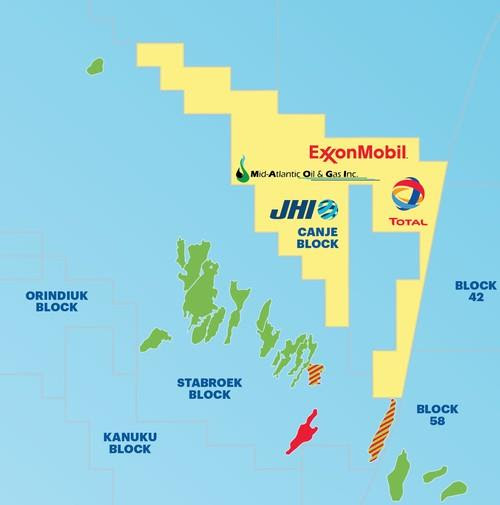Guyana:
ExxonMobil’s Jabillo-1 well disappoints
05 Jul 2021
Eco (Atlantic) Oil & Gas received a detailed update from JV partner JHI Associates regarding the ExxonMobil-operated Jabillo-1 well in the Canje Block, offshore Guyana. The well reached its planned target depth and was evaluated but showed no evidence of commercial hydrocarbons. Jabillo-1 will be plugged and abandoned. This well was drilled at no cost to JHI or Eco and was completed on a full carry basis.

Source: JHI Associates
The Stena DrillMax Rig is currently operating in the ExxonMobil Operated Stabroek Block and is expected to move on to drill the Sapote-1 well, in the eastern portion of the Canje Block. The Sapote-1 Well is expected to be spud in mid-August 2021 with an estimated drilling time of up to 60 days.
The Sapote-1 prospect is located in the south eastern section of Canje, and is a separate and distinct target from Jabillo. Sapote-1 lies approx. 100 km southeast of Jabillo and approximately 50 km north of the Haimara discovery in the Stabroek Block which encountered ~207 feet (63 meters) of high-quality, gas-condensate bearing sandstone reservoir and approx. 60 km northwest of the Maka Central discovery in Block 58 which encountered ~164 feet (50 meters) of high-quality, oil-bearing sandstone reservoir.
Eco recently acquired a 6.4% interest in JHI with the option to increase its stake to 10% on a fully diluted basis. JHI, a private company incorporated in Canada, holds a 17.5% Working Interest in the Canje Block and was carried on the Jabillo-1 well.
Eco remains well funded to progress its planned Orinduik Block drilling program, subject to partner approval, and now as a result of this recent investment in JHI, it is also fully funded for the ongoing program on Canje Block that includes the upcoming committed Sapote-1 well and any additional potential wells considered for this year.
The Canje Block is operated by ExxonMobil and is held by Working Interests partners Esso Exploration & Production Guyana (35%), with TotalEnergies E&P Guyana (35%), JHI Associates (17.5%) and Mid-Atlantic Oil & Gas (12.5%).
Gil Holzman, Co-Founder and Chief Executive Officer of Eco Atlantic, commented:
‘While today’s update from JHI is disappointing, this is the nature of oil exploration. Our stakeholders continue to support our exploration efforts and look for us to continue to define these near term high impact opportunities. Our next focus is the Sapote-1 prospect to be spud in the upcoming weeks which brings us another opportunity to share in what we hope to be another major ExxonMobil led discovery. JHI was carried on the Jabillo-1 well and this is just the first in a series of exploration wells that Eco expects to be involved in this year and next. Guyana has proven to be one of the most prolific hydrocarbon regions on the globe and the high discovery ratio continues and the Company continues to be excited about its near-term future prospects on both the Orinduik and the Canje Blocks.
‘The next well in the program, Sapote-1, is located adjacent to existing discoveries and it is expected to be spud in mid-August 2021. The targets in the region have proven to hold some hundreds of millions of barrels of oil and oil equivalent and we look forward to similar scaled results from this upcoming well.
‘I am happy that we managed to become a part of JHI and the Canje Block exploration program in time that offers our stakeholders a stream of high impact catalysts and an ongoing drilling program operated by ExxonMobil. I have a great confidence that our Canje Block exposure will yield great returns and oil discoveries as it also paves the way to a broader exposure and collaboration in the Guyana-Suriname Basin.’
Source: Eco Atlantic
05 Jul 2021
